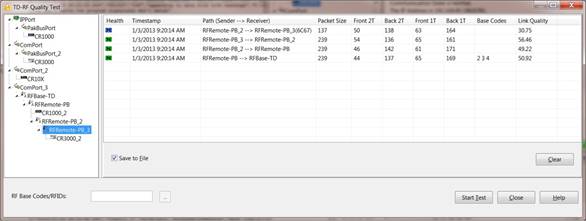Tools | TD-RF Test
This selection launches the TD-RF Quality Test window from which one can execute RF Link Quality Test and/or activate the Advanced Features of the TD-RF modems. The features and functions accessible through the TD-RF Quality Test window are applicable only to TD-RF devices in the network (RFBase-TD, RFRemote-TD, and RFRemote-PB).
The left-hand pane of the TD-RF Quality Test window displays the network map as configured in LoggerNet, and provides a means of selecting a device or an RF path to be tested. The branches of the network map can be expanded or collapsed by clicking the small triangle to the left of the parent device. The devices in the network map can be individually selected, but cannot be otherwise manipulated.
The right-hand pane of the TD-RF Quality Test window displays the results of successful RF Link Quality tests as well as events activating or deactivating the Advanced Features of the TD-RF modems. The most recent entries are added to the top of the display. A maximum of one thousand entries are retained in the display, after which the oldest entries are deleted as new entries are added.
Column Descriptions
Health– Applicable only to an RF Link Quality Test, one of three icons will appear in this column providing a graphical indicator of the relative health of the associated RF link
Timestamp – The server time for when the test response or command acknowledgement was received.
Path (Sender --> Receiver)– Indicates the relative function of the devices involved in the associated test or command.
Packet Size– Applicable only to an RF Link Quality Test, this is the size in bytes of the test packet received by the RF modem. See TD-RF Quality Report.
Front 2T – Applicable only to an RF Link Quality Test, this is the minimum transition point of all T2 transitions within the tolerance window. See TD-RF Quality Report.
Back 2T– Applicable only to an RF Link Quality Test, this is the maximum transition point of all T2 transitions within the tolerance window. See TD-RF Quality Report.
Front 1T – Applicable only to an RF Link Quality Test, this is the minimum transition point of all T1 transition within the tolerance window. See TD-RF Quality Report.
Back 1T– Applicable only to an RF Link Quality Test, this is the maximum transition point of all T1 transitions within the tolerance window. See TD-RF Quality Report.
Base Codes – The codes sent to the Base modem to activate the Advanced Features or define an RF path for the RF Link Quality Test.
Link Quality – Applicable only to an RF Link Quality Test, the Link Quality indicator provides an intuitive means of quickly determining the relative merit of RF Links. If tracked over time, one can easily identify variances and trends in link quality.
The numerical value for Link Quality is derived from the detailed information contained in the TD-RF Quality Report and has a theoretical range of 0 to 102, with greater values equating to greater quality. In practice, the maximum value can only be achieved in a laboratory environment, and the minimum value will never be returned as it is indicative of an inability to decode the test pattern; the RF Link Quality test would timeout. In the real world, typical values for a viable link will fall into mid-range.
The following equation is used to derive the Link Quality value:
Q = [102 – (StdDev(F1T,B1T,F2T,B2T))] * (TestPktSize / (237+NumRptrs)
Where:
Q = Link Quality
StdDev() = Population standard deviation
F1T = Front 1T
B1T = Back 1T
F2T = Front 2T
B2T = Back 2T
TestPktSize = Number of bytes reported in the test packet
NumRptrs = Number of RF repeaters in the complete RF path
Save to File– When this checkbox is checked, all entries in the right-hand pane are also written to a text file in LoggerNet’s working directory (C:\Campbellsci\LoggerNet\Logs\RFTestResults.log). Entries in the file are limited to maximum of ten thousand records. After reaching the limit, the oldest two thousand records are deleted.
"1/3/2013 9:20:14 AM" "RFRemote-PB" "RFBase-TD" 239 44 137 65 169 50.92
"1/3/2013 9:20:14 AM" "RFRemote-PB_2" "RFRemote-PB" 239 46 142 61 171 49.22
"1/3/2013 9:20:14 AM" "RFRemote-PB_3" "RFRemote-PB_2" 239 54 136 65 161 56.46
"1/3/2013 9:20:14 AM" "RFRemote-PB_2" "RFRemote-PB_3(6C67)" 137 50 138 63 164 30.75
Clear– Clicking this button clears the contents of the right-hand pane.
Start Test– The action taken when this button is activated depends on the device selected in the network map.
With an RFRemote-PB or RFRemote-TD selected: An RF Link Quality Test will execute on the branch of the network map comprising the selected RFRemote-TD/PB and the associated RFBase-TD.
With an RFBase-TD selected: The RF Base Codes/RFIDs field is enabled and the entries in this field will determine the action taken. See RF Base Codes/RFIDs.
RF Base Codes/RFIDs: - When enabled by selecting an RFBase-TD in the network map, the RF Base codes or RFIDs entered in this field will determine the action taken when the Start Test button is activated.
RF Base codes: Entering a supported command string of numeric values, separated by a space or comma, will activate the associated Advanced Features in the RFBase-TD or specified RFRemote-TD/PB.
RFIDs: Entering one or more RFIDs, separated by a space or comma, defining an RF path will initiate an RF Link Quality Test on the specified path. This feature allows one the option of testing an RF path that, with the exception of the selected RFBase-TD, may or may not be composed of devices configured in the network map.
 When enabled by selecting an RFBase-TD in the network map, the Browse button will open the Advanced RF Commands window for selecting and executing Advanced Features in the RFBase-TD or specified RFRemote-TD/PB.
When enabled by selecting an RFBase-TD in the network map, the Browse button will open the Advanced RF Commands window for selecting and executing Advanced Features in the RFBase-TD or specified RFRemote-TD/PB.



